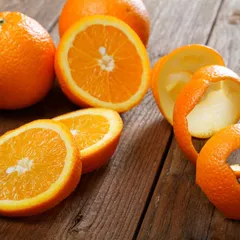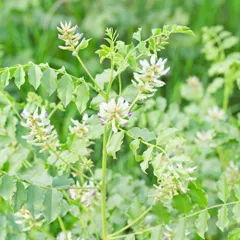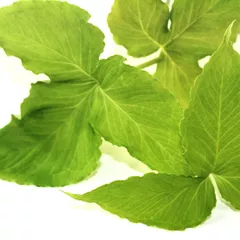Jie Nue Qi Bao Yin
Chinese: 截疟七宝饮
Pinyin: Jié Nüè Qī Bǎo Yǐn
Other names: Seven-Treasure Drink to Check Malarial Disorders




Jie Nue Qi Bao Yin
Chinese: 截疟七宝饮
Pinyin: Jié Nüè Qī Bǎo Yǐn
Other names: Seven-Treasure Drink to Check Malarial Disorders
Ingredients: 7 herbs
Category: Formulas that vent membrane source
- Regulates Cold and Heat
- Harmonizes the Stomach
- Directs rebellious Qi downward
Contraindications: Dichroae root is toxic and should be used with caution. It is toxic if the... Dichroae root is toxic and should be used with caution. It is toxic if the dosage is between 15-75g. Preparation of the formula according to the instructions provided will help reduce side effects. This formula is not indicated for Deficient or chronic conditions. see more
Source: Formulary of the Pharmacy Service for Benefiting the People in the Taiping Era (1107)
The information provided here is not a replacement for a doctor. You shouldn't use it for the purpose of self-diagnosing or self-medicating but rather so you can have a more informed discussion with a professional TCM practitioner.
Jie Nue Qi Bao Yin is a 7-ingredient Chinese Medicine formula with Dichroa Roots (Chang Shan) as a principal ingredient.
Invented in 1107, it belongs to the category of formulas that vent membrane source. Its main actions are: 1) regulates Cold and Heat and 2) harmonizes the Stomach.
In Chinese Medicine health conditions are thought to arise due to "disharmonies" in the body as a system. These disharmonies are called "patterns" and the very purpose of herbal formulas is to fight them in order to restore the body's harmony.
From a Western Medicine standpoint, such patterns can give rise to a range of conditions such as malaria for instance.
On this page, after a detailed description of each of the seven ingredients in Jie Nue Qi Bao Yin, we review the patterns and conditions that Jie Nue Qi Bao Yin helps treat.
The seven ingredients in Jie Nue Qi Bao Yin

Chang Shan is a king ingredient in Jie Nue Qi Bao Yin. Like the name indicates, it means it has more power than other ingredients in the formula.
1. Dichroa Roots (Chang Shan)
Part used: Dry root
Nature: Cold
Meridian affinity: HeartLiverLung
Category: Herbs that drain Dampness
Chang Shan is specialized in checking malarial disorders but also expels Phlegm and removes Stagnation in the interior. This herb is bitter, acrid, cold, and toxic.

Bing Lang is a deputy ingredient in Jie Nue Qi Bao Yin. This means it helps the king ingredient(s) treat the main pattern or it serves to treat a coexisting pattern.
2. Areca Nuts (Bing Lang)
Part used: Dried ripe seed
Nature: Warm
Meridian affinity: Large intestineStomach
Category: Herbs that expel parasites
Bing Lang promotes the descent of Qi as well as urination. The combination of Areca nut and Tsaoko fruit has a long history in treating malarial disorders.

Cao Guo is a deputy ingredient in Jie Nue Qi Bao Yin. This means it helps the king ingredient(s) treat the main pattern or it serves to treat a coexisting pattern.
3. Tsaoko Fruits (Cao Guo)
Part used: Dried ripe fruit
Nature: Warm
Taste(s): Pungent
Meridian affinity: SpleenStomach
Category: Aromatic herbs that transform Dampness
Cao Guo is acrid and warming to strongly dry Dampness. It also strengthens the Spleen Yang and facilitates the venting of
lurking malarial pathogens to the Exterior. The combination of Areca nut and Tsaoko fruit has a long history in treating malarial disorders.

Hou Pu is an assistant ingredient in Jie Nue Qi Bao Yin. This means that it either serves to reinforces the effect of other ingredients or it moderates their toxicity.
4. Houpu Magnolia Bark (Hou Pu)
Part used: Dried stem bark, root bark or branch bark
Nature: Warm
Meridian affinity: LungSpleenStomach
Category: Aromatic herbs that transform Dampness
Hou Pu is a Qi-moving herb that transforms Dampness. Houpu Magnolia bark is acrid, warming, and aromatic.

Qing Pi is an assistant ingredient in Jie Nue Qi Bao Yin. This means that it either serves to reinforces the effect of other ingredients or it moderates their toxicity.
5. Green Tangerine Peel (Qing Pi)
Part used: Dried pericarp of the young or immature fruits
Nature: Warm
Meridian affinity: GallbladderStomachLiver
Category: Herbs that regulate Qi
In general Qing Pi's main actions are as follows: "Smooths the flow of Liver Qi and releases Stagnation. Reduces Food Stagnation. Dries Damp and reduces Phlegm."
In the context of Jie Nue Qi Bao Yin, it is used because it is bitter and warming that breaks up the Qi Stagnation.

Chen Pi is an assistant ingredient in Jie Nue Qi Bao Yin. This means that it either serves to reinforces the effect of other ingredients or it moderates their toxicity.
6. Tangerine Peel (Chen Pi)
In general Chen Pi's main actions are as follows: "Warms the Spleen and regulates the Middle Burner Qi. Dries Dampness and disperses Phlegm from the Lungs and Middle Burner. Reduces the potential for Stagnation caused by tonifying herbs."
In the context of Jie Nue Qi Bao Yin, it is used because it regulates the Spleen and moves the Qi.

Gan Cao is an envoy ingredient in Jie Nue Qi Bao Yin. This means that it directs the formula towards certain area of the body and/or harmonizes the actions of other ingredients.
7. Liquorice (Gan Cao)
Part used: Dried root and rhizome
Nature: Neutral
Taste(s): Sweet
Meridian affinity: HeartLungSpleenStomach
Category: Tonic herbs for Qi Deficiency
In general Gan Cao's main actions are as follows: "Tonifies the Basal Qi and nourishes the Spleen Qi. Clears Heat and dispels toxicity. Moistens the Lungsexpel phlegm and stop coughing. Relieves spasms and alleviates pain. Harmonizes and moderates the effects of other herbs."
In the context of Jie Nue Qi Bao Yin, it is used because it plays a role of harmonizing the action of the whole formula while tonifying the Stomach and Spleen.
Formulas similar to Jie Nue Qi Bao Yin
Da Yuan Yin is 57% similar to Jie Nue Qi Bao Yin
Qing Pi Tang is 44% similar to Jie Nue Qi Bao Yin
Ping Wei San is 43% similar to Jie Nue Qi Bao Yin
Su Zi Jiang Qi Tang is 38% similar to Jie Nue Qi Bao Yin
Wei Ling Tang is 33% similar to Jie Nue Qi Bao Yin
Zhou Che Wan is 30% similar to Jie Nue Qi Bao Yin














